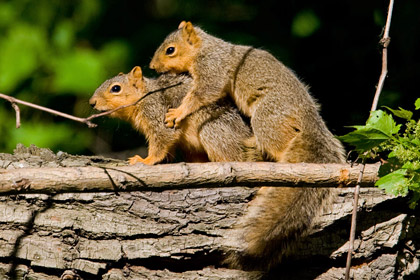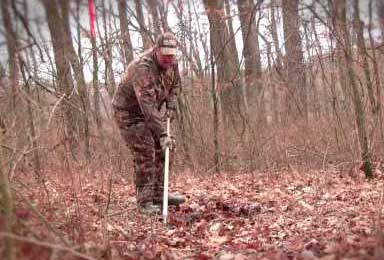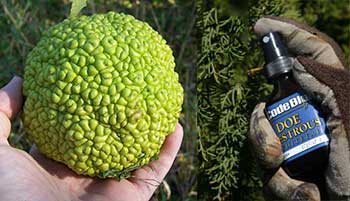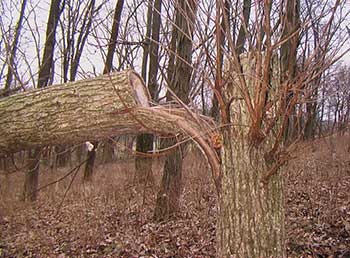One of the most common statements I get after doing one of
my whitetail (bootcamp) hunting educational sessions is how much I "detail" a
stand set-up. I always thought everyone did this but apparently not. There are
many pieces of the puzzle to consider, in fact, too many for this short
article. But I did want to touch on a few details to get guys to thinking, if
nothing else it will make you consider some secondary options. I'm purposely going
to try not to even get into the "big picture" regarding land contours and/or
structural positioning. This will not be an "easy read". It might even seem
confusing and possible questions will arise. But the fact is it will make you a
better hunter. Feel free to draw out little schematics if it will help you to
understand.
Three must-haves for your 2014 Deer Season!
1 Pick the right tree
Once in the right region you must pick the right tree. I've
said many times before I prefer a mediocre tree in a great position over a
great looking tree in a mediocre spot. The fact of the matter is it's not often
you find a great tree in a great spot.
2 Minimize disturbance

Deer know when the forest is disturbed and when it's not. If things are too quiet, it alarms them. These squirrels are undisturbed, unless they happen to be exhibitionists.
One of the most important aspects of a
great stand is an entrance/exit that will create as little disturbance as
possible. Hunting an undisturbed area is fundamental. There is a normal rhythm
in nature. When everything is copasetic there will be the normal "buzz."
Background noises of birds, insects, frogs, etc. are accepted and expected in
the everyday norm. Temporary silence is a sign of disturbance. Area wildlife
will pick up on it. I learned this little tidbit from John Wayne. He was
sitting around the campfire one night when his buddy (note... NOT his partner)
said, "It's really quiet tonight." To which the Duke answered, "Yeah... TOO quiet
pilgrim." That's one of the reasons I'm an advocate of arriving an hour early
over a minute late in most stand situations. I want that buffer to lessen the
adverse effects of my disturbance. Disturbing the "buzz" is also why I'm a big
advocate of quietly remaining in position once the ambush has been established.
Changing stands, leaving for and/or returning from a lunch break, a potty-break
or whatever, will all disturb the normal buzz, thus costing you a half hour
before common expected noises return. Game in the immediate area will
definitely pick up on this.
3 Plan your entrance/exit Strategies
A low impact entrance/exit is vital. The smart hunter must
consider sight, sound and scent in his approach and departure. Let's use an
example of each in illustration. Often your stand placement might be just off
the crest of a ridge-line. HUMAN nature is for old logging/skid roads to follow
the crest of a ridge. It just makes sense for ease of travel for humans and
equipment. But it doesn't make sense for the deer. Although not always the
case, game will shy away from being sky lined on a ridge top. They will
normally tend to walk parallel to the crest on the downwind side. It will
depend on the angle of the terrain and visibility (density) but usually they
will prefer just far enough off to the side to keep their silhouette not
obvious, yet passage where they can see downhill more so or equal to being
crested. You'll also notice their passage will tend to be on the downwind side
of the crest. Think about it. It's just common sense. They can see just as well
or better downhill; they can wind/scent check areas upwind and still not be silhouetted.
We, as hunters, must do the same thing. When entering a stand site along a
ridge line it's easy to walk the logging road along the top. This is fine when
it's dark (another advantage of stand approach before light). But when it's
already light, or in the afternoon, you're usually better off picking your way
in walking parallel to the crest.
If you do walk in on a logging road, I try to walk in the
"tire track" of the downwind side. In other words as an example, say the
logging road is running north/south and the wind is coming from the west. You
walk in the east tire track so the wind carries your residual ground scent off
the road. This insures any deer that happen to be walking the logging road
later will be less likely to smell your passage. Adjunctive to this, if you use
a scent drag on approach you will notice it will benefit you even more so. Tie
a scent soaked rag to a short cord off a four foot switch (or your bow tip) and
drag it (in the example above) down the west tire track while you walk the east
(downwind) track.
4 Carry your clothing
Because I'm a sweater I normally carry my extra coats/gear
in a backpack. When I get within 100 yards or so of the stand I'll stop and put
on my layered jacket, facemask, gloves and safety belt/harness. To ensure a silent
approach I like to rake out steps to the stand. It's an obvious advantage on
having your scent on final approach blowing away from the direction you think
the deer will be coming/going.
5 Create a quiet path
For those of you who have hunted bears over a bait site you
will notice when multiple bears are hitting bait they will approach it via
specific foot prints. This is a dominant/subordinate situation. A subordinate
bear knows if he is caught by a dominate bear on approach to the bait he'll get
his butt kicked and it could be a fatal mistake. Therefore, if you look closely
around the bait site you'll see distinct, separate foot prints/ pad marks that

Raking footsteps in leaves allows you to create a quiet approach to your stand in late fall. I've been doing this for years.
will insure the bear a more silent approach. The subordinate will actually
place his feet in the exact same footprint as a previous entrance/exit for a more
silent approach. I like to do a similar thing when approaching my stand site.
After the foliage drops in the fall you'll have six inches
of dry leaves covering the ground. Trying to walk though dry cornflakes quietly
is pretty hopeless. If there is a cadence/rhythm to your gait it's almost
impossible to keep your entrance/exit covert. Therefore, I'll use the "bear
trick" to my advantage. Preseason I'll take a regular garden rake (the one
with the stiff teeth, not a yard/leaf rake) or a hoe and clear away the fallen
leaves every couple feet for quiet foot placement. This is especially important
on quiet days or if within hearing and/or sight of a known bedding area. Of
course there are variables but I've often quietly slipped into a pre-set,
pre-raked stand and taken advantage of the situation. You'll quietly climb into
the stand and fifteen or twenty minutes later notice an ear twitch only 100
yards away. Binoculars will confirm it's a bedded deer and you'll suddenly realize
there would have been no way in hell you would have gotten to that point and
into the stand unknowingly had you not pre-raked your approach.
After I rake my steps in I take my trusty ratchet hand
pruners and clear away any underbrush I might brush against going in/out. This
is not only just for minimal scent retention but for less noise of the
under-story rubbing against the fabric of your pant legs. This is all just
common detailing.
6 Minimize your scent during approach
I should note here I tend to weigh the odds accordingly. For
example, on approach to a stand it's just smart hunting to not walk down or across
game trails on entrance/exit. BUT if you think a circling approach will disturb
too much area I opt for a more direct approach and actually cross the trail I'm
hunting. In example, say you are hunting a main travel pattern running
east/west. The stand is on the north side of the trail hunting a south wind.
Your most likely approach might be to circle the stand and come in from the
north. But if you do that you might be disturbing too much area and defeat your
covert purpose. So, your best approach will be to walk in from the south where
you have pre-raked and clipped a low impact entrance. When you hit the
east/west trail, wearing rubber boots, just step across the trail leaving
minimal scent and disturbance. Just to be on the safe side I ALWAYS in
situations like this cross the main east/west trail right IN a shooting lane.
That way if you should happen to leave any minor ground scent when crossing and
deer stop to check it out at least they'll be standing broadside in a shooting
lane.
7 Rolling Scents to invoke curiosity
This is another applicable situation for "bowling for
bucks." On the way into the above scenario I like to pick up a couple hedge
apples (Osage oranges) with gloved hands. For those not familiar with them,
they are the fruit of Osage trees. They are yellowish/green, about the size of
a grapefruit, with a coarse texture on the outer surface. The outer surface is
grooved in a squiggly pattern looking similar to a brain. To make it somewhat
confusing, hedge apples and Osage oranges are the same thing... when comparing
apples to oranges. Farmers use the trees themselves for fence posts because
they tend to take a long time to finally ground rot. Hence the term "hedge row."
And of course we all know the Osage wood is commonly used to make beautiful
bows. Anyway, after climbing into my stand I'll take the hedge apple and run a
bead of scent/lure around the fruit. By the way, those who don't have Osage in
their hunting area can use a regular apple. It's just that the grooved outer
surface of the Osage will accept the scent (especially a gel scent) better than
the smooth surface of an eating apple. After running the scent around the apple
while in my stand I then throw/roll it across the trail right through my shooting
lane. Using the same above scenario, if you approach the stand from the south
with rubber boots, cross the east/west trail in a shooting lane, then roll a
scent laden apple across the trail from north to south, the trap has been set.
Think about it. The deer comes walking down the trail until it hits the
residual scent laid down when the apple rolled across the trail. Because of his
ability for directional tracking he'll stop in the trail and look the direction
the scent was rolled/ laid out. It will offer you a broadside shot in a
shooting lane at a standing animal upwind of you looking the opposite direction
from you. Perfect. No directional, audible bleat needed.

Barry uses Osage oranges and deer lures then rolls them down lanes to influence movement.
As mentioned above, I'll often play the odds. Bear with me
on this. Even though it might be a little confusing this is important stuff. Draw
it out if it'll help. Let's use the same hypothetical set-up with an east/west
trail, on the north side of run, facing south with a south wind. Say it's more
of a morning stand with the feeding area to the west and the bedding to the
east. If it's a rut stand you might have deer movement east/west 50/50. But if
it's pre-rut or post-rut 70% of the deer might be moving west to east in the
morning and 70% movement will be from east to west in the afternoon/evening. I
like to play the odds in my favor. Therefore I'll have two additional shooting
lanes cut for multiple options. Say you're looking straight south. If you want
a broadside shot with the deer going west to east I cross the trail a few yards
to the east and roll the hedge apple from straight north to south in order to
stop the deer broadside before he cuts my track. This way you are playing the
70% odds over the 30%. If you prefer a quartering away angled shot I cut two
additional shooting lanes. Again, you are facing straight south so I'll cut a
shooting lane to the southeast for morning movement and another to the
southwest for evening movement. If you prefer the quartering away angle you
then cross the trail in the morning in your southeast shooting lane and roll
your scent ball accordingly across the south lane. The exact opposite is used
for the afternoon sit with entrance via the southwest lane. Clear as mud right?
Play the odds in your favor.
8 Use hinge cuts to force shot distance
I also play the odds with hinge-cuts and blockages. Before
we get into hinge-cuts let's talk about girdling. For those not familiar with
girdling, it's a practice where someone cuts a circle all the way around the
bark/trunk of an upright living tree. It can be done with an axe, hatchet,
handsaw or chainsaw. This will cut off the life-blood and kill the tree. It's a
practice used to kill a tree, which will eventually fall and open up the
canopy, therefore allowing more light to enter the surrounding grounds to
stimulate a thicker understory and better habitat densities. Yes, the tree will
die, the problem is it will fall whatever the direction the wind happens to be
blowing that particular day. You have no control over it. Whereas, with hinge
cutting you create the same effect but are able to control the drop angles to
your benefit. If you do any girdling or hinge cutting make sure you have total
permission from the landowner and he/she understands what you are doing.

Barry uses Hinge Cutting to help direct the deer to within his shooting range.
I much prefer hinge cutting so I am in control of the
angles. My definition of hinge cutting is cutting the upright tree straight across
horizontally until it can be dropped/pushed over in the right direction.
Because the tree is not girdled nor cut all the way through, it hopefully
continues to live. Yes, the tree will be horizontal to the ground but it
should still be able to draw water and nutrients up from the soil. This opens
the canopy allowing sunlight into the surrounding area, yet the still alive
tree allows for continued leafing and promotes supplemental feed as well as
ideal bedding/cover with increased ground level densities. You get the benefit
of both worlds.
I prefer to use a handsaw on trees that are usually six to
eight inches in diameter and usually under forty or fifty feet tall. The hand
saw is tougher but it allows me to control the horizontal cut and keep it
minimal until I can push the tree the exact direction I want it to drop.
Normally I will make my cut just under four feet above ground level. I want to
use the hinge cut as a blockage in order to nudge normal deer movement
whichever direction I want. I prefer the hinge cut at about four feet because I
want the blockage high enough to shift their movement, yet low enough they'll
not duck under the obstruction.
Because I only hunt with a recurve bow I prefer my shots to
be at 12 to 15 yards. Not under 10 yards and not over 20 yards... but that's just
me. Using the same directional example of a stand set-up as we did earlier,
bear with me on this. The stand is overlooking an east/west trail and you are
facing south. But the trail is, let's say, 25 yards from your stand and you
want to shift the 70% W/E morning movement about 12 yards closer to you,
offering a 13 yd. shot. You pick a tree on your side (north) of the E/W trail
and with your saw cutting four feet up, saw until you can swing the drop of the
top of the hinge-cut tree to the southwest. This angle is very important. You
want the brushy top of the tree (which is wider than the base main truck) to
make an obvious barrier to the west to east (70% morning) walking deer. If you
drop the tree straight north to south the perpendicular angle might just force
the deer to jump over the blockage. If you drop it to the southeast it might
angle him away from your stand defeating your purpose. Whereas dropping it at
a SW angle will nudge the deer closer to your stand as he angles along the
blockage. If you would have dropped the tree in a SE angle on a west to east
moving deer he may just swing wide and not give you the shot at all. The
obstruction laying SW (in this case) will offer you a 13 yard shot rather than
a 25 yard shot.
If you want to make sure the E/W (afternoon) movement also
is nudged closer to your stand you need to hinge cut a second tree about half
way up the SW laying barricade. Drop it so the top faces southeast rather than
southwest. Just make sure the base of the second tree is close enough to the
first tree so an E/W traveling deer won't slip between the two trees and angle
away from you again defeating your purpose. If it will help you to understand please
draw these little schematics as explained so you truly understand.
The same effect can be reached if you want to shift a deer's
movement AWAY from your tree. I personally don't like really close shots at under
ten yards. Therefore, you can create an angled blockage right under your tree
in order to shift him from five yards to maybe twelve yards.
I apologize if this was a little hard to follow along. It's
actually very simple but sometimes hard to explain. The bottom line is there will
be a lot of satisfaction in your efforts. Not only will you watch a deer react
exactly as you wanted and intended him to, but your efforts will hopefully
shift his movement into a position where you almost can't miss the sucker-shot.
And that in itself will help bowhunting success rates tremendously.